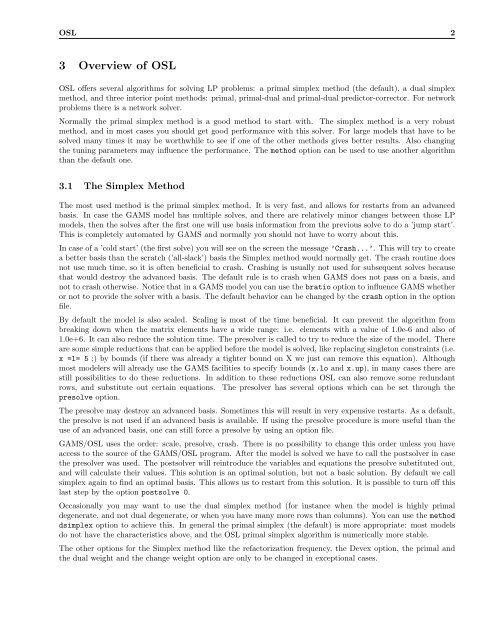1 Introduction 2 How to Run a Model with OSL
1 Introduction 2 How to Run a Model with OSL
1 Introduction 2 How to Run a Model with OSL
- No tags were found...
Create successful ePaper yourself
Turn your PDF publications into a flip-book with our unique Google optimized e-Paper software.
<strong>OSL</strong> 23 Overview of <strong>OSL</strong><strong>OSL</strong> offers several algorithms for solving LP problems: a primal simplex method (the default), a dual simplexmethod, and three interior point methods: primal, primal-dual and primal-dual predic<strong>to</strong>r-correc<strong>to</strong>r. For networkproblems there is a network solver.Normally the primal simplex method is a good method <strong>to</strong> start <strong>with</strong>. The simplex method is a very robustmethod, and in most cases you should get good performance <strong>with</strong> this solver. For large models that have <strong>to</strong> besolved many times it may be worthwhile <strong>to</strong> see if one of the other methods gives better results. Also changingthe tuning parameters may influence the performance. The method option can be used <strong>to</strong> use another algorithmthan the default one.3.1 The Simplex MethodThe most used method is the primal simplex method. It is very fast, and allows for restarts from an advancedbasis. In case the GAMS model has multiple solves, and there are relatively minor changes between those LPmodels, then the solves after the first one will use basis information from the previous solve <strong>to</strong> do a ’jump start’.This is completely au<strong>to</strong>mated by GAMS and normally you should not have <strong>to</strong> worry about this.In case of a ’cold start’ (the first solve) you will see on the screen the message ’Crash...’. This will try <strong>to</strong> createa better basis than the scratch (’all-slack’) basis the Simplex method would normally get. The crash routine doesnot use much time, so it is often beneficial <strong>to</strong> crash. Crashing is usually not used for subsequent solves becausethat would destroy the advanced basis. The default rule is <strong>to</strong> crash when GAMS does not pass on a basis, andnot <strong>to</strong> crash otherwise. Notice that in a GAMS model you can use the bratio option <strong>to</strong> influence GAMS whetheror not <strong>to</strong> provide the solver <strong>with</strong> a basis. The default behavior can be changed by the crash option in the optionfile.By default the model is also scaled. Scaling is most of the time beneficial. It can prevent the algorithm frombreaking down when the matrix elements have a wide range: i.e. elements <strong>with</strong> a value of 1.0e-6 and also of1.0e+6. It can also reduce the solution time. The presolver is called <strong>to</strong> try <strong>to</strong> reduce the size of the model. Thereare some simple reductions that can be applied before the model is solved, like replacing single<strong>to</strong>n constraints (i.e.x =l= 5 ;) by bounds (if there was already a tighter bound on X we just can remove this equation). Althoughmost modelers will already use the GAMS facilities <strong>to</strong> specify bounds (x.lo and x.up), in many cases there arestill possibilities <strong>to</strong> do these reductions. In addition <strong>to</strong> these reductions <strong>OSL</strong> can also remove some redundantrows, and substitute out certain equations. The presolver has several options which can be set through thepresolve option.The presolve may destroy an advanced basis. Sometimes this will result in very expensive restarts. As a default,the presolve is not used if an advanced basis is available. If using the presolve procedure is more useful than theuse of an advanced basis, one can still force a presolve by using an option file.GAMS/<strong>OSL</strong> uses the order: scale, presolve, crash. There is no possibility <strong>to</strong> change this order unless you haveaccess <strong>to</strong> the source of the GAMS/<strong>OSL</strong> program. After the model is solved we have <strong>to</strong> call the postsolver in casethe presolver was used. The postsolver will reintroduce the variables and equations the presolve substituted out,and will calculate their values. This solution is an optimal solution, but not a basic solution. By default we callsimplex again <strong>to</strong> find an optimal basis. This allows us <strong>to</strong> restart from this solution. It is possible <strong>to</strong> turn off thislast step by the option postsolve 0.Occasionally you may want <strong>to</strong> use the dual simplex method (for instance when the model is highly primaldegenerate, and not dual degenerate, or when you have many more rows than columns). You can use the methoddsimplex option <strong>to</strong> achieve this. In general the primal simplex (the default) is more appropriate: most modelsdo not have the characteristics above, and the <strong>OSL</strong> primal simplex algorithm is numerically more stable.The other options for the Simplex method like the refac<strong>to</strong>rization frequency, the Devex option, the primal andthe dual weight and the change weight option are only <strong>to</strong> be changed in exceptional cases.
















